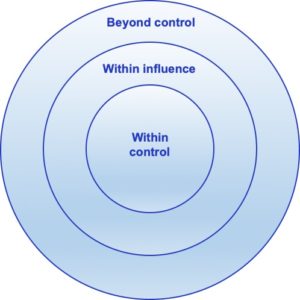In last month’s Insight, we took a closer look at the personal story of a man who really struggled to give direction to his life. But he managed to change its course even though all the odds were stacked against him. Vincent Fantauzzo’s story holds a number of key lessons. Lessons which can make a real difference for anyone who wants their life to be different in some way.
This month’s Insight focuses on one of those lessons: changing the direction your life is taking by focusing on the things you can control and influence. It offers you a stepwise method to help you identify concrete steps forward in your own specific context and situation.
1. Introduction
Let’s assume you’re not quite happy with the direction your current life is taking. One way to change this would be to take some drastic decisions and radically change course.
While this can definitely be a viable strategy, it can often be a bit too much. We may not be sure which direction we actually want to go. Or we may lack resources or skills. There may be a range of circumstances that don’t allow us to leave the lives we’re living. Or there may be parts of our current life we wouldn’t want to lose.
Whatever the reason, we sometimes need to start with small steps in changing the direction our lives are taking. But where to begin?
In the following paragraphs, you’ll find a practical method to help you on your way. It consists of 3 different phases:
- Phase 1: Setting eyes on a new direction
- Phase 2: Identifying effective steps to focus on
- Phase 3: Taking action and moving forward
Phases 1 and 2 include a number of steps across a 6-week period (also see figure 1). This includes time to reflect on your thinking, do some further testing and adjust your ideas if necessary.

You could allow yourself less time to complete these phases, but I only recommend you do so, if you already have clear and specific ideas around what you want to change in your life.
Phase 1: Setting eyes on a new direction (week 1 to 3)
Let’s focus on Phase 1. This phase is all about possible future direction. It focuses on generating ideas on what you’d want to be different in your life.

To start, find a place where you ideally won’t be interrupted for a while and where you can keep your writings as private as you’d want them to be. Bring some paper and a pen (or alternatively a laptop or other device) and write about what you’re experiencing. Use the questions below to guide you.
Take some time and write whatever comes to mind. There are no right or wrong answers. Everyone is different. Every life is unique. Focus on capturing what you really think and feel.
Also, don’t worry about getting all your answers clear straight away. You probably won’t. The point is that the process will help you gain more insights over time. You can always change or add to your story later.
If you notice yourself judging your thoughts and feelings, write both your thoughts/feelings and your judgments of them down. They are all part of who you are and of your journey.
Note that I’m asking you to write, to actually put your thoughts on paper instead of just thinking them. The act of writing makes a difference! I won’t go into its scientific background here, but if you’d like to know more about how writing can help you, please see the article on writing as a technique.
Use at least 1 A4 page for Phase 1, but feel free to use more if you’re not done saying what you have to say.
A. Your life’s current direction
First, focus on the way you’re leading your life at this moment.
-
- What is it about your current life that gives you the feeling that it’s not heading in a direction you want it to go?
- What effects does that have?
- What do you think might happen, if you don’t change direction? What does this mean to you?
Write full sentences, not just keywords. And write whatever comes to mind until you feel you’ve written the most important things down.
B. Imagine …
Part B focuses on developing ideas around what direction you’d want to take. This step is about dreaming. It’s about imagining what life could be like. Don’t worry about not knowing how to get there or how realistic something may appear to you! Phase 2 below will help you look at actions you can take to get closer to where you’d want to be.
First, take a moment to reflect on what you’ve just written in part A. Does it tell you anything about the most important thing(s) you’d want to be different in your life?
Give yourself a few minutes to consider. Then check which of the following 3 descriptions applies to you most. Read that part and follow the indicated instructions.
1. You already have some ideas around how you’d want your life to be different
If this is you, write a few paragraphs about your ideas. It doesn’t matter whether they are general or specific.
Allow yourself to dream a little bit. What would your life look like if your ideas came true? Remember: in this phase, don’t worry about not knowing how to get there. Try to include some vivid descriptions in your writing or even find some actual images – from magazines, Internet or otherwise.
=> Next step: After writing about your ideas, read the instructions under C.
2. You’d want your life to be different, but have no idea in what way
If this is you, think about the 1 or 2 most important things that either really inspire you or that you strongly believe in. Write at least half an A4 page about what it would mean if these were a bigger part of your life.
Does this give you any ideas about what you may want for the future?
-
-
- If it does, write a few paragraphs about those ideas and about what your life might look like if your ideas came true. Allow yourself to dream. Use your imagination. Don’t worry if you don’t know how to get there or if it seems very far removed from your current life. We’ll get to that in the next phase.
=> Next step: After writing about your ideas, read the instructions under C.
- If it does, write a few paragraphs about those ideas and about what your life might look like if your ideas came true. Allow yourself to dream. Use your imagination. Don’t worry if you don’t know how to get there or if it seems very far removed from your current life. We’ll get to that in the next phase.
-
-
-
- It’s also perfectly possible that this process doesn’t give you any ideas on what you may want for the future. That simply means that this method doesn’t work as well for you right now as other methods might. So let’s find another way for you to generate ideas on the direction you’d like your life to take!
=> Next step: Stop following this Insight’s instructions and instead go to the article “Small and simple things to start with today“. It offers you a range of other methods to generate ideas. Begin your journey from there.
- It’s also perfectly possible that this process doesn’t give you any ideas on what you may want for the future. That simply means that this method doesn’t work as well for you right now as other methods might. So let’s find another way for you to generate ideas on the direction you’d like your life to take!
-
3. You don’t really know how you’d want your life to be different, nor what really inspires you or what you strongly believe in.¹
This happens sometimes. For example, when you’ve lived a life in which you’ve had to put your own wishes aside for some time. Or when life has simply evolved without you having to question how you felt about these things. If this is you, it likely means you need a little bit more experimenting and testing to get in touch with what you want.
=> Next step: Stop following this article’s instructions and instead go to the article “Small and simple things to start with today“. It offers you a number of ways to broaden your experiences and to experiment with different possible directions. Begin your journey from there.
C. Allow time for testing, reflecting and adjusting
At this point, it’s important to take a step back. Keep the things you’ve written in a safe place and let them be for the next 3 weeks.
In the meantime, you have some homework to do.
-
- See if you can find ways to further confirm or develop your ideas. Perhaps by doing some research on topics related to your ideas or talking about them with a trusted friend. Perhaps you could even try something that is part of your ideas, like a little experiment.
- Try to be conscious of the things you’re thinking and feeling throughout the 3 weeks. If anything pops up in your mind that you’d like to add to or change in what you’ve written, make a separate note or include it directly.
- If the list of things you’d want to be different in your life is now longer than 3, select the one (at most 2) that will likely make the biggest difference.
After 3 weeks move on to Phase 2, but feel free to return to Phase 1 if you ever feel the need to. Often, this is not a linear process and many people find themselves going back and forth between the steps as they gain insights and experiences.

Phase 2: Identifying the most effective steps to focus on (week 4 to 6)
You now have your eyes set on 1 or 2 important things that you’d want to be different in your life. And you’ve given yourself some time to verify your thoughts.
It’s time to move to Phase 2, which centres on identifying the most effective steps to focus on going forward.

Again, you need a place where you can have some time to yourself and which is sufficiently private, as well as a pen and some paper to write on (or alternatively, a laptop or other electronic device).
Specifically part B also lends itself for a large, colourful exercise on a flip-chart or whiteboard using markers and post-it notes (see instructions under part B below). Don’t worry though, if you don’t have access to those. A few pieces of paper and a pen work just as well!
A. Orientation (week 4)
Reflect for a moment on those 1 or 2 most important things you’d want to be different. How far away do they seem to you compared to your current life?
Maybe it feels like you’re already close and that you could make it happen very easily. But it may also feel like that different life is very far away. Perhaps it even appears so far away, that it hardly seems achievable. If that’s the case, bear with me. This is not the time to give up just yet!
There are probably certain things that need to happen to turn your ideas into reality.
As an example, let’s say you’d like to have a job. You may need to develop new skills and knowledge. You likely need to write a resume, get invited to an interview and make it through a selection process. Or in a more relationship-based setting, people need to know you’re available to work and the right people need to put in a word for you to get hired.
Give yourself a few minutes to reflect on the essentials of what you’d like to be different in your life. Then make a list of the things that need to happen to get closer to where you want to be. Think, for example, of actions you need to take, phases you need to go through, things you need to learn, et cetera.
Write your answers down as a list of keywords. Try to think of as many things as possible (of course you can add additional thoughts later). When you can’t think of any more items, think about the following 2 questions and again add your answers as keywords to your list.
-
- What (or who) are you dependent on in this process?
- What are your main concerns in whether you will succeed or not?
When you run out of items to list, it’s time to take a step back again. Keep your list in a safe place and let it be for about a week. During this week, change or add to the list if you have any additional thoughts or ideas.
B. Identify the different elements (week 5)²
You now have a list of keywords – actions, phases, people, objects etc. – that reflect the different things that need to happen to make your ideas come true. You’ll likely find you need to change elements of this list as time progresses. That is absolutely fine!
Time to get a little creative now!
Take a new piece of paper and a pen. If you’re doing a large version of this step, take your flip-chart/whiteboard, markers and post-its.
Draw 3 circles on your paper or whiteboard/flip-chart:
-
- a medium one in the middle of the space
- another circle around it
- and an even bigger circle around that still
Call the smallest circle “within control”, the middle circle “within influence” and the biggest one “beyond control”.
Something like figure 4:

Now take your list and have a closer look at your keyword answers. Don’t do anything with them just yet. Only examine them.
You will find that some items reflect something that is completely beyond your control; there’s little you can do yourself to change anything about them. Other items reflect something you may be able to influence, but not fully control. And then there will be items that reflect something you have full control over.
As an example (not in keywords, to make it easier to explain):
What I’d like to be different: “I really want to change jobs and do something completely new.”
-
-
- Beyond my control:
– the job market situation - Within my influence, but not fully within my control:
– my partner’s feelings about my ambitions
- Fully within my own control:
– keep on practicing, even if it’s challenging or I can’t spend as much time as I would like
- Beyond my control:
-
Now do the following:
-
- Find the keywords in your list that are clearly “beyond your control” and write them in the “beyond control” circle. If you’re using post-its, write each item on a single post-it and stick them in the circle.
- Next, find the keywords that are clearly “within your influence, but not completely within your control” and write or post them in the “within influence” circle.
- Next, find those that are clearly “fully within your own control” and write or post them in the “within control” circle.
- For the keywords that now remain on your list, you will probably find that some of them are made up of different elements that belong in different circles. If that is the case, make these different elements explicit in different keywords and write/post them in the right circle.
- If any keywords now remain, see if you can convert them into relevant items and write/post them in the right circle.
Two more steps to go now in this part B:
-
- Have a closer look at the keywords in your circles. For each one, check if they’re really in the right circle. If necessary, move them to another one.
- For each of the items you have listed in the “beyond control” and “within influence” circles, challenge yourself to come up with at least 1 item that is completely within your control and add it to your “within control” circle.
In our example:
– I’m not able to control the job market (“beyond control”), but I am able to study it so that I know the situation well and can identify opportunities (add to “within control”).
– I’m able to influence but not fully control my partner’s feelings about my ambitions (“within influence”), but I am able to ask how s/he feels and take his/her concerns seriously (add to “within control”).
When you’ve completed this challenge, it’s time to take a step back again. Keep your items in the circles in a safe place and allow yourself a week to generate additional thoughts or ideas. Change or add to your circles accordingly.
C. Add focus (week 6)
The last part of Phase 2 is about consciously reflecting on where to focus your time and energy. You’ll be more effective in changing your life in the right direction, if you focus on the things you can control yourself, while keeping an eye on the things you can influence and acting when appropriate. It is far less effective to spend your time and energy on things you cannot control.
This may sound logical and simple, but it’s often easier said than done. Many of us end up worrying about things we have no control over, or feeling frustrated or angered by them. We may even end up trying to control something beyond our control. Time and energy we could also have spent on things we can actually control or influence.
In this week 6, do the following:
-
- Look at the items in your circles and identify the most important concrete steps or actions for the near future. Select them mostly from your “within control” circle and – to a lesser degree – from your “within influence” circle. Get ready to start doing them!
After this, you can begin Phase 3 immediately, but if you prefer to give yourself another week to consider any additional thoughts, that’s fine as well.
Phase 3: Taking action and moving forward … (week 7 and beyond)
It’s time to start taking steps and move forward.

If your current life doesn’t require a lot of change to turn it in the direction you want, then you may not need a lot of time to succeed.
But if you find yourself far from the direction you want your life to take, it may require more time and energy for you to get there. The trick is to keep focusing on the things you can control and to keep on going.
This will likely go in waves: sometimes you’ll find it easy to persevere, other times you’ll find it more challenging. For instance, because you can only take little steps at a time. Or because it’s unclear if the actions you’re taking bring you closer to where you want to be. What’s important is to try and do something every day – even if it’s only something very small.
As time progresses, take a moment every once in a while to check how you’re doing. You may find it helpful to take out your keywords in the circles again and ask yourself:
- Which of the circles draws most of my time and energy?
- Is there a good balance between the circles when it comes to the time and energy I’m spending?
- How can I focus less on things I cannot control, and more on things that lie within my control or at least within my influence?
Here are some additional tips you may find helpful:
- If you have a lot of new skills or knowledge to learn or are faced with completely new and daunting experiences, have a look at the article “Too much to learn? Here’s what to do …” for some guidance in the process.
- If you find that your habits get in the way of changing direction, for example because they keep you from taking actions you should be taking, have a look at the article “Habits: Your worst enemies … or your best friends?“.
- If you’re looking for some inspiration in the form of a real-life example of someone who has had to work hard to change the course of his life and who managed to do so by persevering, have a look at the story of Vincent Fantauzzo if you haven’t already done so.
2. When to believe … and when to be realistic?
This kind of life change often requires “belief”. Belief in yourself. Belief in the process. Belief that you can make it in spite of the odds. The challenge is to keep going as long as there’s a chance you’ll get to where you want to be. Even if you can only take small steps at a time. For sure, humans are capable of doing incredible things and making astounding life changes.
But the way our bodies and brains are wired through our DNA, combined with where we are in life and the things we’ve been through, give us not only tremendous potential but also our limits. In spite of what we’d sometimes like to believe, we cannot become anything we want.
At age 47, I could never become the next world champion sprinting, no matter how much time I’d spent training. And Vincent Fantauzzo, whose story featured in the January Insight, could never become an expert at spelling. His dyslexia is simply too severe. But … his brain did allow him to develop – through dedicated practice over years – an uncanny ability in painting portraits that capture the essence of the person drawn.
So perhaps the question we should be asking is not “When to believe … and when to be realistic?”, but rather “How am I unique and what does that mean in terms of the things I am capable of?”
Footnotes
1. Not being able to connect with what inspires you or what you strongly believe in is something that happens to people regularly.
A few examples:
- If you’ve lived the past 5 years caring for a partner with severe dementia and have had to put your own life “on hold”, you may have lost touch temporarily with what inspires you.
- Or perhaps you’ve gone through life making all kinds of steps along the way that seemed logical at the time you made them, but that got you to a place you now realise you don’t want to be. You may for the first time in your life have to think about what inspires you or what you believe in and may be at a loss for your own answers.
- Maybe something drastic happened in your life that has had a major impact on you, leaving you unsure of what you’d want in life.
However, not being able to connect with what inspires you or what you strongly believe in can also be an expression of a form of lethargy linked to depression or other mental health problems. This is beyond the reach of the current article. If you suspect that this is the case for you, I strongly advise you to seek support of a healthcare professional or – if you don’t have access to one – a trusted friend.
2. This approach is loosely based on the circles of concern, influence and control that have been introduced to the general public by Stephen R. Covey through his well-known book “The 7 habits of highly effective people”, originally published in 1989 by Free Press.

